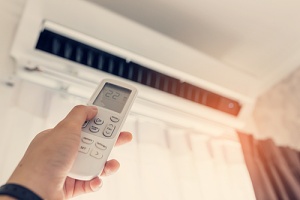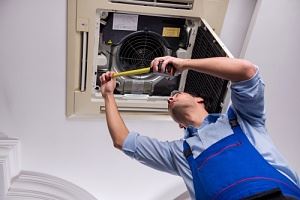Presidential Heating & Air Conditioning
Gaithersburg HVAC Contractors
Share
Share on FacebookTweet
Tweet this0Share
Share on LinkedIn0 shares on LinkedIn Air conditioning systems come in a wide variety of styles, shapes, sizes, and efficiencies, with an ever-growing range of upgrades and smart features. Before you make a final decision on which one might work for your home or office, take the time to learn about the different systems and what you can get for your money.
Air conditioning systems come in a wide variety of styles, shapes, sizes, and efficiencies, with an ever-growing range of upgrades and smart features. Before you make a final decision on which one might work for your home or office, take the time to learn about the different systems and what you can get for your money.
Available Air Conditioning Systems
Here is an overview of the different types of systems that are readily available right now:
Central Air Split System
Central air conditioning is a system in which air is cooled at a central location. The most common type of central air system in the United States is a split central air system, where one mechanical component is located outside and one component is located indoors. These two components work together using coils to cool the air in your home. Fans circulate the cool air throughout the home and discharge warm air outside.
The outdoor unit consists of a compressor, the condensing coil, the condenser fan, and a grill cabinet to protect against contact with the fan blade, controls, and two refrigerant lines that run into the home to the evaporator coil. The compressor compresses the refrigerant gas which enables it to discharge heat out of the house, creating cool air.
The evaporator coil is located in the indoor unit. Compressed refrigerant is pumped from the exterior condensing coil to the interior evaporator coil, where it absorbs the heat from the air. The cooled air is then pushed through the ductwork via the room vents throughout your home to lower the interior temperature. Meanwhile, the refrigerant circulates through the system back outside to the condenser coil, where the heat that was absorbed is released to the outside. At this point, the refrigerant is returned to a liquid form, continuing the cycle of the refrigerant compression and flow.
As a general rule of thumb, every 500 or 600 square feet of space in your home requires one ton of cooling. Applying that rule of thumb, a 1,500 square foot home would need a three 000-ton unit and the cost of installation is around $4,000 on average. A 2,000 square foot home would need a four-ton unit with installation running about $4,500 on average. An experienced HVAC technician can perform the necessary load calculation for you to ensure you get the right-sized system. The newer systems are quite energy-efficient and are not expensive to run. You can get additional savings by installing a smart thermostat to manage its operation.
You can save a little on the cost by adding a new central air system to an existing forced-air heating system. This allows you to use your furnace blower and existing ductwork to distribute cool air throughout the home.
Heat Pump
Heat pumps are a type of split system. In the summer, the heat pump expels heat from the house and releases it outside. In the winter, it extracts heat from the outdoor air and uses it to warm the house. In mild climates, heat pumps are a good choice for both heating and cooling. In colder climates, you may be interested in a geothermal heat pump. It works by drawing heat out of the ground rather than the air. Heat pumps are very cost-effective in the long run, but the initial cost can be almost 50% more than other systems.
Ductless Mini-Split
The mini-split system is ideal for small spaces or spaces with no ductwork. It is also a great choice for older homes or buildings where installing ductwork for a central air system is simply not feasible. These mini-split systems are low profile air conditioners that are usually mounted on a wall inside the room or in the ceiling. As its name indicates, the mini-split systems operate with two primary components: an outdoor compressor/condenser, and an indoor air-handling unit.
One primary advantage with these systems provides cooling in homes and office spaces without using ductwork, saving you money on the cost of installing or modifying ductwork. The absence of ductwork not only saves money on the initial installation, but it also provides another benefit: these systems allow you to avoid the energy losses associated with central air ductwork. When air conditioning ducts are in an uncooled space such as an attic, they can account for losses of more than 30% of the energy consumption used by the system.
The initial cost of a mini-split is about twice that of a window-mounted unit. However, each zone is controlled with its own thermostat, and you only pay to cool the space when it is occupied. These air conditioning systems take up very little space but they pack a lot of comfort and power. A single outdoor compressor/condenser can support up to four indoor air-handler units. That means one outdoor unit can cool up to four rooms. Also, it provides heating as well as cooling, so you get a lot for the money and installation is fairly straightforward.
Packaged Unit
A packaged central air conditioner encloses the evaporator, condenser, and compressor in a single cabinet. The entire unit can be placed outdoors on the roof or on a concrete slab next to the home’s foundation. The air supply and air return ducts connect with the outdoor unit through the home’s exterior wall or roof. Packaged air conditioners often include electric heating coils or a natural gas furnace. The packaged unit combines an air conditioner and a central heater, which eliminates the need for a separate furnace indoors.
Portable and Room Air Conditioners
A room air conditioner can be a window-mounted unit or a portable unit. It is a budget-friendly way to cool a room or addition to your home. If you have it installed in a window, make sure you have a knowledgeable technician handle the installation or you will have problems with air leakage. These are very budget-friendly. They are also beneficial for supplemental cooling of select rooms and save money on energy bills. However, window units are not aesthetically pleasing and portable units take up floor space. They need to be vented to the outside and are best used for supplemental cooling.
Contact the HVAC Experts at Presidential Heat and Air for More Information
If you need to make a decision on a new air conditioning system for your home or office, speak to one of the professionals at Presidential Heat and Air for more information. A qualified technician can come to your home for an evaluation to help you get the best system for your lifestyle and your budget!


